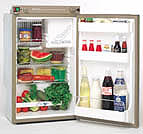
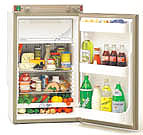
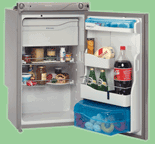
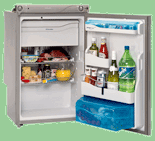
 |
 |
 |
 |
| RM 4230 | RM 4271 | RM 6270 | RM 6290 |
These days most caravans have a fridge and with most caravanning taking place during the summer months it’s important it works efficiently. In this article we look at how caravan fridges work, how to best use them and what can go wrong.
How caravan fridges work
Unlike domestic fridges
caravan fridges have no compressor to pump the refrigerant around relying
instead on heat to do the pumping. It may seem perverse to use heat to cool
something but it does work and it has one big advantage - that the heat can be
generated in a variety of ways. Thus a caravan fridge can operate on mains
electricity, 12 volts or gas.
Fridges based on this principle are known as absorption fridges, the process being invented by Electrolux some 70 years ago. Absorption fridges have a number of other advantages.
Firstly they are totally silent in operation. Secondly the refrigeration unit has no moving parts, and therefore (in theory) requires no maintenance at all. Secondly the refrigeration unit has no moving parts, and therefore (in theory) requires no maintenance at all. Thirdly the refrigerant contains no Freon or other CFC's. Thirdly the refrigerant contains no Freon or other CFC's
With all these advantages you may be wondering why all fridges are not made that way. The main reason is that the heat pump is not as efficient as a compressor so more power is needed to achieve the same level of cooling.
So how does heat get to cool your fridge? Well I’ll have to get a tad technical to explain, but then this is the technical section of our Club website after all!
Basically the heat is used to heat a boiler containing strong ammonia/water solution. This causes the ammonia to evaporate. The hot gaseous ammonia is then passed through an air cooled condenser where it condenses into liquid ammonia. This liquid then passes via a small hole into the evaporator where it evaporates. As it does so it cools, drawing away the heat from inside the fridge via the freezer box and fins.
The evaporation process is aided by the presence of hydrogen which lowers the vapour pressure of the ammonia thereby encouraging it to evaporate. The net effect is the same as can sometimes be seen on a liquid propane gas cylinder when the outside becomes frosted as the gas is drawn off.
Once the gases have passed through the evaporator they are mixed with weak ammonia solution returned from the boiler and collect in the absorber unit. The ammonia gas dissolves in the weak ammonia liquid making it strong once again and ready to be returned to the boiler for another cycle. Potential corrosion arising from the water is inhibited by the addition of a small amount of sodium chromate.
Operation and maintenance
Absorption fridges can
take a while to cool down so bear this in mind before putting perishable food
inside. If possible operate the fridge for about 3 hours first. Don't be
tempted to operate your fridge on gas and electricity at the same time to boost
performance. It is likely that the fridge will be damaged through overheating.
To maintain top performance defrost your fridge when the ice layer on the cooling plates reaches a thickness of 3mm. Let the ice melt naturally, do not use a scraper or apply direct heat.
Most caravan fridge freezer compartments are two star rated and so are not really suitable for freezing food but they are fine for storing pre-frozen food.
Some owners have asked me if they can tow the caravan with the fridge running in gas. My answer is always that this is potentially dangerous, especially in the event of an accident, and positively illegal if you pull onto a filling station forecourt.
I occasionally get asked about whether it is possible to run a caravan or motorhome fridge on gas during a ferry crossing. Unfortunately, for safety reasons, the answer is no - ferry operators expressly forbid it! For short crossings of an hour or two, the fridge should remain adequately cool until you are able to drive again, provided the contents were sufficiently cooled beforehand. For longer journeys the fridge and contents may not stay cool, so it is best to purchase fresh produce on arrival at your holiday destination.
One trick I sometimes use is to get 3 or 4 frozen freezer blocks (as used to cool non-powered cool boxes) and place them inside the fridge to help keep things cool. Alternatively we sometime freeze the milk beforehand so it helps to keep the fridge cool during longer ferry crossings.
Caravan
Fridge Problems
Poor performance on
site
The most common problem brought to my
attention is inadequate performance during hot weather. In most cases this has
been due to inadequate cooling of the heat exchanger pipework at the rear of the
fridge. This problem can arise for a variety of reasons.
If a fridge is on
the nearside of a caravan, the use of an awning in hot weather can drastically
reduce the cooling available via the fridge vents. In these circumstances make
sure you leave enough of the awning unzipped to get a decent flow of air through
it. Secondly the caravan door may partially obscure the vents when it is latched
back.
If you plan to travel on the continent during the summer then consider fitting a small 12 volt computer fan behind the top fridge vent to increase the airflow during hot weather. It will make a big difference to the performance of the fridge and only consume a small amount of power.
Poor performance can also arise where the fridge installation is less than ideal. Newer vans are quite good in this respect but older ones sometimes left a little to be desired. The most critical area is that immediately above the rear of the fridge. All the warm air arising from this area should be ducted straight to the top vent via an upwards sloping plate and given no chance to hang around. This will help to create the necessary draught to pull cool air in via the bottom vent. A possible sign of an installation problem is if the worktop above the fridge becomes warm.
If you have doubts about your fridge installation contact your local caravan workshop for advice. Alternatively, if you are a Club member, see me on a rally and I'll take a look.
Some owners with older vans have resorted to fitting a small 12 volt computer fan just inside the top grille to assist airflow. If all else fails this is worth a go. The fans are normally quite effective and consume very little power.
Whilst most UK mains hook-ups are fine some continental ones can suffer from low voltage during times of heavy load. So if your fridge performs badly whilst running on mains electricity abroad try switching to gas. Indeed if your fridge performs badly on one power source it's always worth trying another if you can. It's always possible that the thermostat is faulty and as the gas and mains electricity systems each have their own thermostat so switching power sources can help to identify the problem. Beware that operation on 12 volts may not give the same cooling effect as mains electricity or gas. This can be because the 12 volt element has a lower rating than the mains one or because of voltage drop or other problems (see paragraph below). Overall it's best to use 12 volt operation simply to help keep the fridge cool when travelling and not to cool or freeze items.
Another cause of poor performance is operating the fridge when it is not level. If you stand in front of the fridge it's most sensitive to tilt from left to right. It is also sensitive from back to front but not so much. Pre 1986 Electrolux fridges have a tilt tolerance of only plus or minus 3 degrees, later ones are much better at plus or minus 6 degrees. At these latter angles a caravan would be uncomfortable to live in so in practice you needn't worry about your fridge being level if you have a 1986 or later model.
Electrolux fridges with just 3 degrees tilt tolerance include models RM122, 123, 212, 212E, 4206, 4207, 4200, 4201.
|
Poor performance when towing When the caravan is being towed the fridge takes its power from the car's 12 volt system. The problem is that quite high currents at 12 volts are needed for the cooling circuit to work properly. Depending on the model the current required is in the range of 9 to 14½ amps. This high current can cause two problems. The first one is that of voltage drop. Put simply this means that whilst the voltage at the towcar's alternator may be around 14 volts the voltage at the fridge may be 10 volts or less.
In one case I looked at recently involving a fridge freezer no less than 4 volts were being lost along the car's wiring. The solution is to run heavier cables from the car's battery and earth points to the 12S socket. The absolute minimum is 2.5 sq mm for smaller fridges and short runs, rising to 6 sq mm for fridge freezers where the cable run is relatively long.` Another problem causing poor performance can be the 12S plug itself. On caravans produced since 1999 the centre pin of this plug acts as the earth return for the fridge. The problem with this is that the centre pin is set forward slightly to act as a guide pin thereby making it likely to get squashed and to function poorly as a conductor. The net result is usually poor fridge performance and an overheated 12S plug/socket. (See separate article). |
|
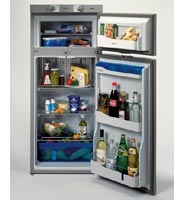 | |
|
|
This RM7655L model fridge freezer requires 14.5 amps at 12 volts to keep cool when towed | ||
With 2004 model year vans and later it's important for the car/caravan selector switch to be set correctly during towing. For caravans fitted with a Dometic fridge this switch should be set to 'caravan' and for those fitted with Thetford fridges it should be set to 'off' - i.e. the central position. By the way, during storage caravans fitted with Dometic fridges should have the selector switch set to 'off' to prevent the caravan's battery being discharged by the fridge's control electronics.
Failure to light or fumes
produced
A well installed absorption
fridge should give many years of trouble-free service but problems can arise
from time to time especially when operated on gas. Spiders and other insects
seem to have an eternal fascination with small gas burners and jets and nest in
them when not in use. The effects can range from a failure to light, to
incomplete combustion where fumes and possibly soot are produced. If this
happens then the burner will have to be serviced. Modern gas regulations mean
this needs to be carried out by an authorised person, e.g. a qualified gas
fitter.
If a fridge fails to light the first thing to check is that it has a gas supply. One item often overlooked is the local isolation valve on the distribution manifold. These manifolds are often sited nearby in a kitchen cupboard and it has been known for one or more of the isolation taps to be accidentally knocked. The fridge tap is sometimes coloured blue.
Another reason for ignition failure is the lack of a spark from the ignition module. One cause of this can be damp, especially if the caravan has been power-washed close to the fridge vents. Other than this there isn't much to go wrong with the push button piezo units although earthing is sometimes a problem. Electronic ignition units have become more reliable over the years and have the advantage of automatically reigniting the flame if it blows out as well as telling you when the gas runs out. If an electronic unit fails to operate the first thing to check is that it is receiving a good 12 volt supply.
Failure to stay
alight
If the flame goes out as soon as
you release the control knob then (assuming you have held it in for the required
20 seconds or so) the flame failure device is likely to be faulty. This is a
safety device designed to shut off the gas supply in the event of the flame
going out. Replacement should only be carried out by authorised
personnel.
No (or very little)
cooling effect
If an absorption fridge has
not been used for a long time it is possible for the chemicals inside it to
separate out. If this happens the fridge will not work on any heat source. The
cure is to take the fridge out, turn it upside down, give it a shake and leave
it upside down for a hour or two. Modern fridges are resistant to this problem
but older ones may succumb. Once again gas regulations means this is a job for
authorised personnel only.
A fridge that still refuses to
work after this treatment is either going to need replacement or a costly
repair.
Over-cooling in cold
weather
All models can suffer from this
but those that are particularly prone to it include RM212, 4206, 4230 and 4200.
The answer is to fit winter covers to the vents whenever the outside temperature
is below 10ºC (50ºF). If you cannot find any to suit your vents then try using
kitchen foil to cover part of the top vent. Don't cover the lower vent as in
some models it acts as an escape point in the event of a gas leak.
Wiring
Changes
Wiring changes to the 12S plug and
socket introduced for the 1999 model year mean that fridges on caravans of this
year or later will not work when towing with vehicles wired to the previous
standard. If you have this problem the answer is to run a separate earth cable
from pin 7 on the socket (i.e. the centre pin) to a good earth on the tow
vehicle.
Servicing
Dometic
(Electrolux) recommend that their fridge burners are inspected and cleaned by
authorised personnel at least once a year. Beware that this does not normally
form part of a caravan's he annual service.
Replacement of an old fridge
If your old
fridge has packed up or you simply want to upgrade it the following table from
Dometic should be useful. Please note that
Installations should be made
by authorised personnel only.
| Old model | Capacity (Ltr) |
Refrigerator measurements |
Replaced by model |
Capacity (Ltr) |
Refrigerator measurements |
| RM 122 | 28 | 586* x 380 x 434 - piezo ignition Thermostatic control on gas operation, 3-stage control for gas operation * Height 662 mm incl. upper grill for inner ventilation. |
RM 123 E | 30 | |
| RM 185 GV
RM 180 |
41 | 620 x 425 x 445 2-stage control for gas operation |
RM 4180
RM 4181 M |
40
40 40 |
|
| RM 200 | 60 | 628 x 486 x 476 - piezo ignition |
RM 4200 | 60 | |
| RM 212 | 60 | 615 x 485 x 472, - piezo ignition, 3-stage control for gas operation |
RM 4200
|
60
|
|
| RM 2200 | 60 | 615 x 486 x 479 - electronic ignition |
RM 4211
alt. RM 4200 |
60
|
Thermostatic control on gas
operation |
| RM 2210 | 60 | 618 x 486 x 480 - electronic ignition |
RM 4211 | 60 | |
| RM 2211 | 60 | 618 x 486 x 480 - electronic ignition |
RM 4211
alt. |
60
|
|
| RM 2250 | 70 | 821 x 486 x 476 - electronic ignition, with wheel arch cut-out |
RM 4231 | 70 | with wheel arch cut-out |
| RM 2251 | 70 | 821 x 486 x 476 - piezo ignition, with wheel arch cut-out |
RM 4230
alt. RM 4231 |
70 70 |
with wheel arch cut-out with wheel arch cut-out |
| RM 2253 | 90 | 821 x 486 x 536 - electronic ignition |
RM 6361
alt. |
90
|
Note! the depth - automatic energy selector AES |
| RM 2254 | 90 | 821 x 486 x 536 - piezo ignition |
RM 6360
alt. |
89 89 |
- piezo ignition - automatic energy selector AES |
| RM 2260 | 70 | 823 x 486 x 485 - electronic ignition with wheel arch cut-out |
RM 4231 | 70 | with wheel arch cut-out |
| RM 2262 | 70 | 823 x 486 x 485 - piezo ignition with wheel arch cut-out |
RM 4230
|
70 | |
| RM 2266 | 77 | 823 x 486 x 485 - electronic ignition |
RM 6271 | 80 | |
| RM 2267 | 77 | 823 x 486 x 485 - electronic ignition |
RM 6271 | 80 | |
| RM 2268 | 77 | 823 x 486 x 485 - piezo ignition |
RM 6270 | 80 | |
| RM 2280 | 90 | 821 x 486 x 476 - piezo ignition |
RM 6360 | 90 | |
| RM 2281 | 90 | 821 x 486 x 476 - electronic ignition |
RM 6361 | 90 | |
| RM 2285 | 90 | 821 x 486 x 474 - automatic energy selector AES |
RM 6365 AES | 90 | |
| RM 2290 | 90 | 826 x 486 x 535 - manual energy selector - 1 knob |
RM 6365 AES | 90 | |
| RM 2291 | 90 | 826 x 486 x 535 - electronic ignition |
RM 6361 | 90 | |
| RM 2292 | 90 | 826 x 486 x 535 - piezo ignition |
RM 6360 | 90 | |
| RM 2601
Frozen Food compartment |
170 + 35 | 1300 x 547 x 627 - piezo ignition |
RM 2610
Full width Frozen Food compartment |
170
+35 |
|
| RM 2606
Frozen Food compartment |
170 + 35? | - electronic ignition |
RM 2610
Full width Frozen Food compartment |
170
+35 |
|
| RM 270 | 70 | with wheel arch cut-out |
RM 4230 alt. RM 6270
RM 6271 |
70
80
80 |
|
| RM 275 P | 70 | 831 x 486 x 480 - piezo ignition |
RM 4230 alt RM 6270 |
70 80 |
|
| RM 275 R | 70 | 831 x 486 x 480 - electronic ignition |
RM 6271 | 80 | |
| RM 300 A
RM 300 C RM 300 P |
80 | 815 x 525 x 536 - piezo ignition, with wheel arch cut-out |
RM 4300 Discontinuedd alt. RM 6270 |
80 80 |
|
| RM 300 D
RM 300 R |
80 | 815 x 525 x 536 - electronic ignition with wheel arch cut-out |
RM 4301 Discontinued
alt. RM 6271 |
80 80 |
|
| RM 301 | 81 | 799 x 524 x 417 - piezo ignition |
RM 4310 Discontinued
alt. |
81 80 |
821 x 486 x 541 |
| RM 3210 AES | 60 | 618 x 486 x 480 - automatic energy selector AES |
RM 4215/AES | 60 | |
| RM 3250 AES | 70 | 821 x 486 x 476 - automatic energy selector AES, with wheel arch cut-out |
RM 4235 AES
alt. RM 6271 alt. |
70?
80 |
|
| RM 400 A
RM 400 C RM 400 P |
103 | 805,5 x 525 x 536 - piezo ignition |
RM 6400 | 103 | |
| RM 400 D
RM 400 R |
103 | 805,5 x 525 x 536 - electronic ignition |
RM 6401 L RM 6401 LM alt |
103 103 |
Note! the height |
| RM 415 AES | 103 | 805,5 x 525 x 536 - automatic energy selector AES |
103 | Note! the height | |
| RM 4270 | 77 | - electronic ignition |
RM 6270 | 80 | - electronic ignition |
| RM 4271 | 77 | RM 6271 | 80 | Note! the depth | |
| RM 4275 | 77 | - automatic energy selector AES |
RM 6275 | 80 | - automatic energy selector AES |
| RM 4290 | 86 | - electronic ignition |
RM 6290 | 90 | - electronic ignition |
| RM 4291 | 86 | - electronic re-ignition |
RM 6291 | 90 | Note! the depth - electronic re-ignition |
| RM 4295 | 86 | - automatic energy selector AES |
RM 6295 | 90 | - electronic re-ignition - automatic energy selector AES |
| RM 4360 | 89 | - electronic ignition |
RM 6360 | 90 | |
| RM 4361 | 89 | - electronic re-ignition |
RM 6361 | 90 | Note! the depth |
| RM 4365 | 89 | - automatic energy selector AES |
RM 6365 | 90 | |
| RM 4400 | 103 | - electronic ignition |
RM 6400 | 105 | Note! the depth |
| RM 4401 | 103 | - electronic re-ignition |
RM 6401 | 105 | Note! the depth |
| RM 4405 | 103 | - automatic energy selector AES |
RM 6405 | 105 | |
| RM 4500 | 135 | - electronic ignition |
RM 6500 | 135 | - electronic ignition |
| RM 4501 | 135 | - electronic re-ignition |
RM 6501 | 135 | |
| RM 4505 | 135 | - automatic energy selector AES |
RM 6505 | 135 | - automatic energy selector AES |
| RM 4700 (bort?) |
165 | - electronic ignition |
RM 6700 | 165 | - electronic ignition |
| RM 4701 | 165 | - electronic re-ignition |
RM 6701 | 165 | |
| RM 4705 | 165 | - automatic energy selector AES |
RM 6705 | 165 | - automatic energy selector AES |
| RM 4300 | 80 | 805,5 x 525 x 536 - piezo ignition with wheel arch cut-out |
Discontinued
alt.
|
|
and the depth with wheel arch cut-out |
| RM 4301 | 80 | 805,5 x 525 x 536 - electronic ignition with wheel arch cut-out |
Discontinued
alt.model RM 6271 |
|
and the depth with wheel arch cut-out |
| RM 663 | 144 | 1034 x 585 627 - automatic energy selector AES |
RM 3500 AES Discontinued alt. RM 2610 Full width Frozen Food compartment |
155
+35 |
|
| RM 3500 AES | 155 | 993 x 585 x 627 - automatic energy selector |
Discontinued
alt. RM 2610 Full width Frozen Food compartment |
+35 |
|
| RA 10 | 30 | 677 x 383 x 390 - Igniter |
RM 123E | 30 | |
| RAM 17 | 44 | 712 x 473 x 470 - Igniter |
RM 4200
|
60
|
|
| RAM 24 | 60 | 712 x 486 x 460 - piezo ignition |
RM 4200 | 60
|
|
|
Footnote Whilst Electrolux (now known as Dometic for leisure appliances) has dominated the caravan market for years, sanitation manufacturer Thetford has has now established itself into this field with a brand new range of products from its Norcold division, which it acquired in 1997. The operation principles are very similar to those of its Dometic rivals so much of the text above will apply. Pictured right are some of the models from Thetford's European range. The units are made at Etten-Leur in the Netherlands, next door to the sanitation manufacturing facility. For the time being Thetford's refrigerators are only available to caravan and motorhome dealers and not to the general public. |
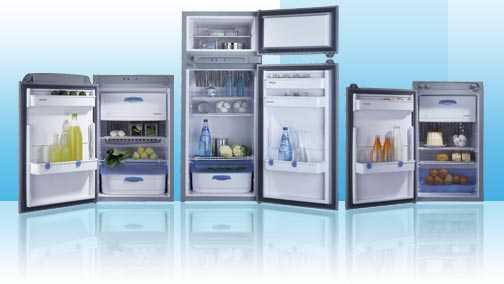 |